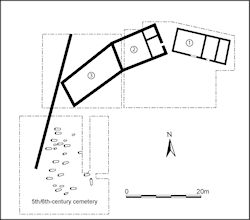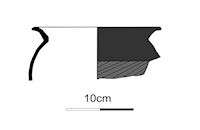
The complex of three late Roman buildings excavated at Bradley Hill (Leech 1981) lie within walking distance of Catsgore (Figure 9). Building 1 had three discernible phases of activity. The first was a series of pits and hearths. A coin of 323-4 was sealed by a paved floor that denoted the next phase of activity and this paving may also have overlain two more coins of AD 364-378. The third phase of activity sealed the paving and was an 'occupation deposit' containing pottery, other finds and a clipped siliqua of Arcadius (AD 392-402) (Leech 1981, 183). The clipping of these coins is considered to have started in the 380s or 390s but 'only became rife after the cessation of fresh supplies of siliquae in 402' (Bland et al. 2013, 137). Outside Building 1 a midden deposit, containing coins of 335-350, 282 sherds of late Roman BB1 (5.678kg) and a fragment Type 18 bowl, built up against the structure's southern wall (Figure 10).

Building 2 produced no Type 18 bowls but had a very similar stratigraphic sequence to Building 1. First phase features were succeeded by a paved floor that sealed coins of AD 364-378 and was overlain by an occupation deposit containing coins of AD 388-402. However, it did not produce any Type 18 bowls, in contrast to Building 3. The third structure was an extension to Building 2 and began its life as a barn or byre. A change of function occurred at an unknown date when the structure was used as a focus for infant burials in a manner similar to that seen at many other Romano-British rural settlements (Millett and Gowland 2015). Finally, an 'occupation deposit' sealed the burials and contained a coin of AD 388-402 as well as a Type 18 bowl (Figure 11).

Bradley Hill has also produced a Fowler D7 penannular brooch of very late 4th or 5th-century date, and to the south of the buildings a small inhumation cemetery was also excavated (Gerrard 2005b). These remains have long been considered to represent the late Roman inhabitants of the buildings. Grave goods were few and far between but include a bead that is perhaps best seen as of 5th-century date and two radiocarbon determinations have returned 5th- to 6th-century dates. This, together with the stratigraphic evidence from the buildings, is a strong indicator that activity continued at this site into the 5th century and that the Type 18 bowls were in use or being deposited at this date.
